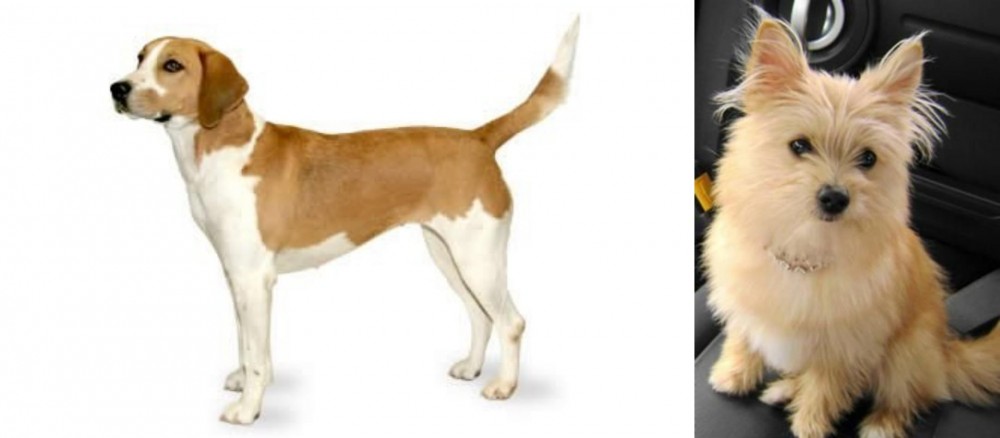 Harrier is originated from United Kingdom but Yoranian is originated from United States. Harrier may grow 20 cm / 8 inches higher than Yoranian. Harrier may weigh 24 kg / 53 pounds more than Yoranian. Both Harrier and Yoranian has almost same life span. Harrier may have less litter size than Yoranian. Harrier requires Moderate Maintenance. But Yoranian requires Low Maintenance
Harrier is originated from United Kingdom but Yoranian is originated from United States. Harrier may grow 20 cm / 8 inches higher than Yoranian. Harrier may weigh 24 kg / 53 pounds more than Yoranian. Both Harrier and Yoranian has almost same life span. Harrier may have less litter size than Yoranian. Harrier requires Moderate Maintenance. But Yoranian requires Low Maintenance
Basic Information
undefined
United Kingdom
United States
Life Span:
12 - 16 Years
12 - 14 Years
Other Names:
Harehound
Yorky Pom • Yorkie Pom • Yorkie-Pom • Yorki-pom • Yorkipom • Yoranian Terrier • Porkie • Pom-Yorkie
Colors Available:
black, but a few come in an unusual mottled blue pattern. , white and tan
crcream to apricot
Coat:
short, glossy coat
thin Thick, short/medium, shiny, wirehaired double coat
Shedding:
Moderate
Moderate
Temperament:
Affectionate, Alert, Energetic, Friendly, Lively, Loving, Stubborn
Curious, Energetic, Intelligent, Loving
Grooming:
Moderate Maintenance
Low Maintenance
Trainability:
Moderate
Easy
New Owners Friendly:
Yes
Yes
History
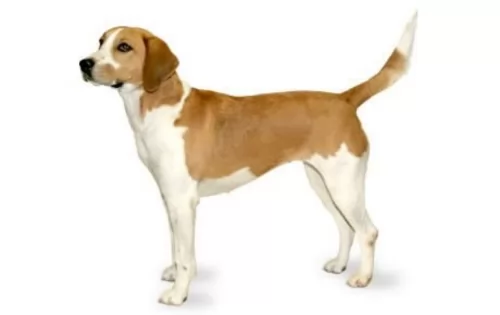 Developed in Great Britain, the Harrier is another hunting dog – a hound that primarily hunts hares and small prey. The breed itself is medium sized - smaller than an English Foxhound and larger than a Beagle. Although the definitive origins of the Harrier are not set, it is believed that he is a cross of the Basset Hound, Talbot Hound and Bloodhound. Others believe the breed is a cross of the Greyhound and the English Foxhound. The Harrier looks like a smaller version of the English Foxhound.
Developed in Great Britain, the Harrier is another hunting dog – a hound that primarily hunts hares and small prey. The breed itself is medium sized - smaller than an English Foxhound and larger than a Beagle. Although the definitive origins of the Harrier are not set, it is believed that he is a cross of the Basset Hound, Talbot Hound and Bloodhound. Others believe the breed is a cross of the Greyhound and the English Foxhound. The Harrier looks like a smaller version of the English Foxhound.
The Harrier is a pack dog and in 1260, Sir Elias de Midhope established the first pack in England. From there the breed spread to Wales and Western England, most used in Ireland where they hunt fox as well as hares. However, hunting hares is the specialty of the breed and even gave the breed its name. In 1885 they were recognized by the American Kennel Club in the Hound Group. Yet despite this and despite the number of Harriers working in England, they are not recognized by the UKC.
The Yoranian is a mixed breed, hybrid or “designer” breed. They are a cross between the Pomeranian and the Yorkshire Terrier and are very small dogs. They were developed in Yorkshire, England in the 19th century. It is a very playful, family dog that is not registered with any pure breed club such as the American Kennel Club or AKC.
Description
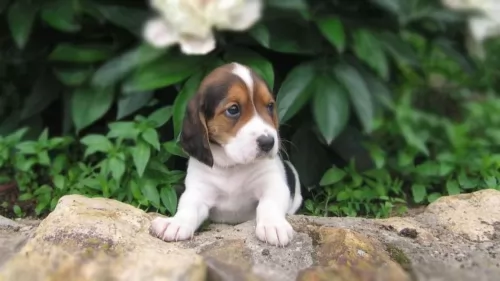 The Harrier is a typical hound dog much like the English Foxhound. The breed is a little smaller than the Foxhound but is muscular and large boned like his cousin. They have short hard hair that sheds and ears that hang. The Harrier is a large boned breed built for strength and stamina in the race with hares. They have broad skulls, strong muzzles, with hazel or brown eyes. They also have a black, wide nose and a high, medium length tail.
The Harrier is a typical hound dog much like the English Foxhound. The breed is a little smaller than the Foxhound but is muscular and large boned like his cousin. They have short hard hair that sheds and ears that hang. The Harrier is a large boned breed built for strength and stamina in the race with hares. They have broad skulls, strong muzzles, with hazel or brown eyes. They also have a black, wide nose and a high, medium length tail.
They say he has a ‘courtly grin’ on an expressive face. Being pack dogs, they must be sturdy, able to cover any type of terrain, for as long as the hare runs. It is critical that their scenting and running tools are exceptional. He is blue or yellow-pied. His feet are cat like and the chest is dropped low. He is an extremely well-proportioned dog
The Yoranian is a toy breed, as are both its founding breeds. It checks in at only 7 pounds and stands only 6-10 inches tall. It can have medium or long fur in any combination of the parent’s colors including tan, black, blue or white. They have small ears that stand upright and erect, a small muzzle, medium tail and large round eyes. They can be long and slender like the Yorkshire Terrier or barrel shaped like the Pomeranian.
Characteristics
Children friendliness
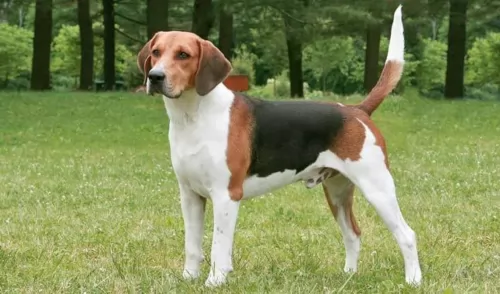 Yes, they are good with children but are very rambunctious and should be supervised with young children.
Yes, they are good with children but are very rambunctious and should be supervised with young children.
Special talents
Scenting ability and wonderful personality
Adaptability
This breed is very adaptable as long as it gets enough exercise. He can live in the country or she can live in the city with an outlet for exercise.
Learning ability
Smart but stubborn at times. Therefore, his learning ability is moderate.
1.Children friendliness absolutely but monitor so that the dog does not get hurt. They are fragile.
2.Special talents – high energy and lots of enthusiasm
3.Adaptability – very adaptable small apartments are great.
4.Learning ability very high gets bored easily
Health Problems
Health Problems
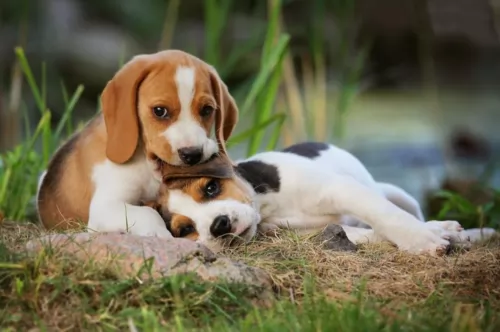 It seems the only real health issue other than hunting accidents or foot and toe incidents due to hunting.is:
It seems the only real health issue other than hunting accidents or foot and toe incidents due to hunting.is:
Hip Dysplasia
This abnormality in the hip socket can cause arthritis and lameness that is very painful. This is the most severe form. The Harrier can have a milder form that does not progress to this level. Hip dysplasia has a genetic component, but the environment plays a role as well and active hunting dogs are especially prone to this.
Ear Infections
Floppy ears that hang down are always susceptible to ear infections. Check them often and clean them at least weekly.
The Yoranian has some medical challenges such as:
• A very fragile neck and back. They can be hurt easily.
• Low Blood Sugar must be monitored.
• Eye irritations and dry eyes without enough tear production.
• Dental issues with decay and loss of teeth.
• Patellar Luxation of slipped kneecaps causing lameness.
• Retinal Atrophy can lead to blindness.
Caring The Pet
Feeding the puppy
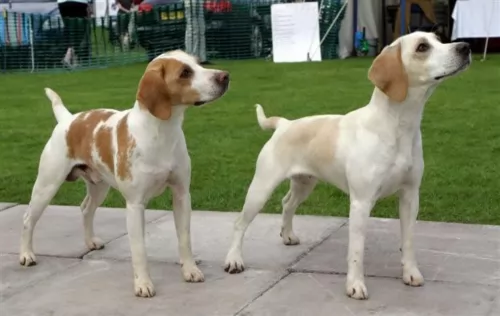 Feed a high nutrition puppy food dry food made for an energetic breed. Feed 3 times a day ½-3/4 cup each time.
Feed a high nutrition puppy food dry food made for an energetic breed. Feed 3 times a day ½-3/4 cup each time.
Feeding the adult
Again feed a high nutrition adult food for an active breed. Feed twice a day 1-11/2 cups each time.
Points for Good Health
Outstanding health unless in a hunting accident.
Games and Exercises
The Harrier is an energetic, hunting breed that needs a lot of exercise on a daily basis. Long walks and jogging or running is good for the Harrier. If they are not working, hunting dogs they need more exercise. A fenced yard for playing is good. If this intense breed does not get enough exercise and mental stimulation, he needs there could be issues with destructive behavior and obesity. Flyball, tracking, agility, coursing, rally and hunting are great activities for this breed of dog. In addition, they are pack animals and do better in a family that has more than one dog.
1 Feeding the puppy don’t overfeed and feed small pieces of toy dog food. 3-4 x per day ¼ cup daily
2.Feeding the adult don’t overfeed/ high quality adult toy dog food. Make sure pieces are small. ¼ to ½ cup daily
3.Points for Good Health – lots of energy and enthusiasm
4. Games and Exercises high energy and enthusiasm at least 2 walks a day.
loves to play inside
Comparison with other breeds
- Harrier vs English Bulldog - Breed Comparison
- Harrier vs German Shepherd - Breed Comparison
- Harrier vs Golden Retriever - Breed Comparison
- Harrier vs Labrador Retriever - Breed Comparison
- Harrier vs West Highland White Terrier - Breed Comparison
- Harrier vs French Bulldog - Breed Comparison
- Harrier vs Beagle - Breed Comparison
- Harrier vs Yorkshire Terrier - Breed Comparison
- Harrier vs Poodle - Breed Comparison
- Harrier vs Rottweiler - Breed Comparison
- Harrier vs Boxer - Breed Comparison
- Harrier vs English Pointer - Breed Comparison
- Harrier vs Siberian Husky - Breed Comparison
- Harrier vs Doberman Pinscher - Breed Comparison
- Harrier vs American Bully - Breed Comparison
- Harrier vs Abruzzenhund - Breed Comparison
- Harrier vs Affenpinscher - Breed Comparison
- Harrier vs Afghan Hound - Breed Comparison
- Harrier vs Aidi - Breed Comparison
- Harrier vs Airedale Terrier - Breed Comparison
- Harrier vs Akbash Dog - Breed Comparison
- Harrier vs Akita - Breed Comparison
- Harrier vs Africanis - Breed Comparison
- Harrier vs Askal - Breed Comparison
- Harrier vs Atlas Terrier - Breed Comparison
- Yoranian vs English Bulldog - Breed Comparison
- Yoranian vs German Shepherd - Breed Comparison
- Yoranian vs Golden Retriever - Breed Comparison
- Yoranian vs Labrador Retriever - Breed Comparison
- Yoranian vs West Highland White Terrier - Breed Comparison
- Yoranian vs French Bulldog - Breed Comparison
- Yoranian vs Beagle - Breed Comparison
- Yoranian vs Yorkshire Terrier - Breed Comparison
- Yoranian vs Poodle - Breed Comparison
- Yoranian vs Rottweiler - Breed Comparison
- Yoranian vs Boxer - Breed Comparison
- Yoranian vs English Pointer - Breed Comparison
- Yoranian vs Siberian Husky - Breed Comparison
- Yoranian vs Doberman Pinscher - Breed Comparison
- Yoranian vs American Bully - Breed Comparison
- Yoranian vs Abruzzenhund - Breed Comparison
- Yoranian vs Affenpinscher - Breed Comparison
- Yoranian vs Afghan Hound - Breed Comparison
- Yoranian vs Aidi - Breed Comparison
- Yoranian vs Airedale Terrier - Breed Comparison
- Yoranian vs Akbash Dog - Breed Comparison
- Yoranian vs Akita - Breed Comparison
- Yoranian vs Africanis - Breed Comparison
- Yoranian vs Askal - Breed Comparison
- Yoranian vs Atlas Terrier - Breed Comparison
 Petzlover
Petzlover Harrier is originated from United Kingdom but Yoranian is originated from United States. Harrier may grow 20 cm / 8 inches higher than Yoranian. Harrier may weigh 24 kg / 53 pounds more than Yoranian. Both Harrier and Yoranian has almost same life span. Harrier may have less litter size than Yoranian. Harrier requires Moderate Maintenance. But Yoranian requires Low Maintenance
Harrier is originated from United Kingdom but Yoranian is originated from United States. Harrier may grow 20 cm / 8 inches higher than Yoranian. Harrier may weigh 24 kg / 53 pounds more than Yoranian. Both Harrier and Yoranian has almost same life span. Harrier may have less litter size than Yoranian. Harrier requires Moderate Maintenance. But Yoranian requires Low Maintenance Developed in Great Britain, the Harrier is another hunting dog – a hound that primarily hunts hares and small prey. The breed itself is medium sized - smaller than an English Foxhound and larger than a Beagle. Although the definitive origins of the Harrier are not set, it is believed that he is a cross of the Basset Hound, Talbot Hound and Bloodhound. Others believe the breed is a cross of the Greyhound and the English Foxhound. The Harrier looks like a smaller version of the English Foxhound.
Developed in Great Britain, the Harrier is another hunting dog – a hound that primarily hunts hares and small prey. The breed itself is medium sized - smaller than an English Foxhound and larger than a Beagle. Although the definitive origins of the Harrier are not set, it is believed that he is a cross of the Basset Hound, Talbot Hound and Bloodhound. Others believe the breed is a cross of the Greyhound and the English Foxhound. The Harrier looks like a smaller version of the English Foxhound. The Harrier is a typical hound dog much like the English Foxhound. The breed is a little smaller than the Foxhound but is muscular and large boned like his cousin. They have short hard hair that sheds and ears that hang. The Harrier is a large boned breed built for strength and stamina in the race with hares. They have broad skulls, strong muzzles, with hazel or brown eyes. They also have a black, wide nose and a high, medium length tail.
The Harrier is a typical hound dog much like the English Foxhound. The breed is a little smaller than the Foxhound but is muscular and large boned like his cousin. They have short hard hair that sheds and ears that hang. The Harrier is a large boned breed built for strength and stamina in the race with hares. They have broad skulls, strong muzzles, with hazel or brown eyes. They also have a black, wide nose and a high, medium length tail. Yes, they are good with children but are very rambunctious and should be supervised with young children.
Yes, they are good with children but are very rambunctious and should be supervised with young children. It seems the only real health issue other than hunting accidents or foot and toe incidents due to hunting.is:
It seems the only real health issue other than hunting accidents or foot and toe incidents due to hunting.is: Feed a high nutrition puppy food dry food made for an energetic breed. Feed 3 times a day ½-3/4 cup each time.
Feed a high nutrition puppy food dry food made for an energetic breed. Feed 3 times a day ½-3/4 cup each time.